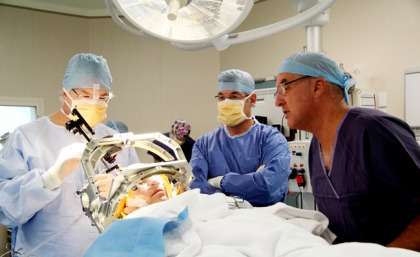Scientists redefine how the brain plans movement

(Medical Xpress)—University of Queensland researchers have made a surprise discovery about how the brain plans movement that may lead to more targeted treatments for patients with Parkinson's disease.
The discovery was made by UQ's Queensland Brain Institute (QBI) researcher Professor Pankaj Sah in collaboration with neurologist Professor Peter Silburn and neurosurgeon Associate Professor Terry Coyne from the UQ Centre for Clinical Research.
Professor Sah said the team examined the brains of 10 patients with Parkinson's disease while the patients were awake during deep brain stimulation surgery, and found more than one part of the brain is responsible for planning movement.
"This study aimed to improve understanding of how different parts of the brain are involved in planning movement and controlling gait," Professor Sah said.
The team was particularly interested in a part of the brain stem known as the pedunculopontine nucleus (PPN), which lies in the deepest part of the brain.
The PPN has previously been targeted as a treatment point for people with advanced Parkinson's disease who are unable to walk.
"To date, we have known that walking is generally controlled by the outer part of the brain known as the cortex," Professor Sah said.
"When you decide to walk, the cortex sends signals to your brain stem which in turn signals the spinal cord to initiate movement.
"We have also known that neurons in the PPN are activated during limb movement, but our study has shown they were also activated when patients were simply thinking about walking.
"This is a complete surprise, because general thinking has been that movement planning takes place in the cortex, but this study indicates it might be happening in the brain stem as well."
Parkinson's disease is the second most common neurodegenerative disorder after Alzheimer's disease, affecting more than six million people globally, and about 1 in 350 Australians.
Professor Sah said improved understanding of how the brain plans movement could lead to more targeted treatments for people with Parkinson's.
"The cells involved in these networks seem to be one type of cell, so when thinking about drug treatments for Parkinson's, maybe we should be targeting these cells," Professor Sah said.
All the patients treated with deep brain stimulation also recorded positive outcomes with improvements with gait, highlighting the importance of neuroscientists working with clinicians.
Findings of the research are published in the Nature Neuroscience journal.
More information: Imagined gait modulates neuronal network dynamics in the human pedunculopontine nucleus, Nature Neuroscience (2014) DOI: 10.1038/nn.3642














